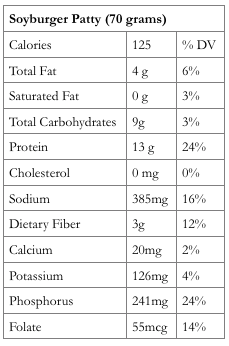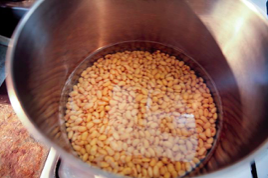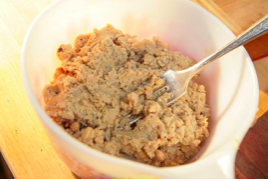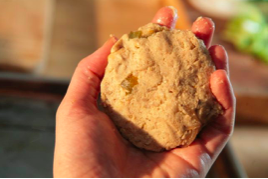SOYBEANS FOR MEAT??
Make burger great again!
Created by: Charisma Tamirin (1901468893) & Gabrielle Natasha Dwi (1901471710)
HOLAA FOODIES! Are you craving for some burger? Yes.. that delicious, melts in your mouth meat with nice fluffy patty that makes you want to eat more and more, but.. scared that you will gain some weight? NO PROBLEM! SOY MEAT BURGER will fulfill your appetite!
Having soy meat alternatives in the pantry or freezer is the perfect way to solve the “What’s for Dinner?” quandary. Fast preparation is why shoppers love these items. There is rarely thawing or pre-browning cooking steps. Most go from package to pan or can be prepared quickly with only an addition of water. Soy meat alternatives can be used in the same way as the foods they replace. Refrigerated soy meat alternatives will keep for 3-4 days while freezer storage varies from 9 to 18 months depending on the product.
Nutrition Highlights
Over the course of time, diet and food trends have been shaping and still reshaping the way we eat. Because of this, sometimes we become confused on what we should and shouldn’t be eating because the trends keep on changing. But, there’s one important thing that we always want to be sure to get from our food: nutrition
Meat alternatives with soy protein will provide a good source of high quality protein, B vitamins, and iron. These are generally very low in total fat and saturated fat, and several are even non-fat. Many provide a good source of dietary fiber. Vegans have several choices that are fortified with B12. Soy meat alternatives and analogs provide important bio-active components, such as isoflavones, which are being studied in relationship to relieving menopausal symptoms, such as hot flashes, maintaining healthy bones, and preventing prostate, breast cancers, and colorectal cancer. The content and profile of bio-active components varies from product to product, depending upon how much soy protein is in the food and how the soy protein is processed.
Soy meat alternatives are a healthy, high-quality protein source that contains all essential amino acids needed for growth. Soyfoods are a good source of essential fatty acids and contain no cholesterol and little or no saturated fat.
In addition to the quality of soy protein, scientists have found that soy protein can contribute to reducing the risk of heart disease by lowering blood cholesterol and increasing the flexibility of blood vessels. The FDA has approved a health claim stating that “25 grams of soy protein in a daily diet low in saturated fat and cholesterol can help reduce total and LDL cholesterol that is moderately high to high.”
One thing that we should understand is that there are two kinds of protein, complete and incomplete. A complete protein has the right proportions of all nine essential amino acids, and is most easily attained from meat, poultry and dairy products. Non animal sources of protein are typically low in some of the essential amino acids. Although they are good sources of protein, they are low in certain amino acids compared to meat. That’s why they’re often called incomplete sources of proteins. Even so, this is not a problem as it will not endanger your health if you’re eating a healthy diet with lots of vegetables and an occasional serving of meat.
Interesting Facts about Soybeans
– One acre of soybeans can produce 82,368 crayons.
– Soybean oil provides an environmentally friendly fuel for diesel engines.
– During the Civil War, soybeans were used in place of coffee because real coffee was scarce.
– 98 percent of the soybean and livestock farms in the country are still family farms.
– U.S. farmers first grew soybeans as cattle feed.
– Soy ink is used to print newspapers and textbooks.
– Soybeans also find their way into candles, cleaning products and hair-care products.
– The soybean is the highest natural source of dietary fiber.
– More soybeans are grown in the United States than anywhere else in the world.
The Making of Soy Meat Alternatives
The development of soy meat alternatives and analogs came about to make soy proteins more universally acceptable. The original soy meat alternatives were made primarily from soy flour and later textured soy flour. Today, soyfoods manufacturers may use textured soy flour, soy concentrates, soy protein isolates or a combination of all, and combine them with other vegetable proteins and ingredients. New technology has now allowed the production and introduction of soy meat alternatives more closely resembling the taste and texture of red meat and poultry products.
Nutrition Facts

Things You’ll Need
2 cups soybeans
6 cups vegetable stock or water
2 tbsp. oil
4 garlic cloves, diced
2 large onions, diced
1 carrot, diced or grated
2 stalks celery, diced
1 green pepper, diced
1 tsp. sea salt
1/2 tsp. oregano
1/2 tsp. garlic powder
1/2 tsp. basil
1/2 tsp. parsley
6 tbsp. tamari
2 tbsp. peanut butter or tahini (optional)
2 cups cooked brown rice
9 Easy Steps to Prepare Soyburger Patties:
1. Soak soybeans in water to cover overnight.

2. Boil soybeans in a pot with vegetable stock or water for about 2 1/2 hours or until thoroughly cooked.

3. Preheat oven to 400 degrees F.

4. Lightly grease a skillet and sautee garlic cloves, onions, carrots, celery and green pepper until soft (about 5 minutes).

5. Using a spoon or similar utensil, mash the soybeans in a mixing bowl with the brown rice.

6. Add all other ingredients to the bowl and mix thoroughly.

7. Form the mixture into patties using your hands.

8. Lightly grease a baking sheet with olive oil.

9. Bake patties in preheated oven for 30 minutes, then serve.

Tips
You can cook more soybeans than you will need for your recipe, then freeze the extra portions for later use. Soy sauce makes an excellent substitute for tamari. The soy patties can also be made as instructed, then fried until crisp in a well-oiled skillet for about 5 minutes on each side.
Source: USDA National Nutrient Database for Standard Reference, Release 17 (2004)
Source: USDA -Iowa State University Database on the Isoflavone Content of Foods, Release 1.3, 2002, USDA Nutrient Data Laboratory Agricultural Research Service
Source: Exchange Lists for Meal Planning, 2nd edition, 2002. The American Diabetes Association/The American Dietetic Association.
http://www.soyfoods.org/soy-products/soy-fact-sheets/soy-meat-alternative-fact-sheet
https://www.leaf.tv/articles/how-to-make-soy-meat/

